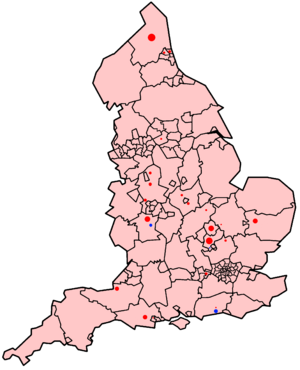List of middle schools in England facts for kids
Middle schools in England are special schools for students in a specific age range. In England and Wales, these schools usually start with students younger than 10 and a half years old and finish with students older than 12 years old. They are different from the usual primary (ages 4-11) and secondary (ages 11-18) school system.
Back in 1983, there were over 1,400 middle schools in England. This number included "combined schools" for children aged 5 to 12. However, by 2019, only 107 middle schools were left. They were found in just 14 local areas across England.
History of Middle Schools
Middle schools were first allowed by a law called the Education Act 1964. This law made it possible for schools to teach students across the usual age 11 divide between primary and secondary schools. It didn't create a brand new type of school. Instead, it allowed for different ways to organize schools. The government could decide if these schools should be treated as primary or secondary.
A person named Alec Clegg, who was in charge of education in West Riding of Yorkshire, really pushed for middle schools. He wanted schools for students aged 9 to 13. This idea was part of a bigger plan to create "comprehensive schools." Comprehensive schools aim to provide education for all students, no matter their background, rather than separating them based on academic ability.
In 1965, the government asked local education authorities to plan for comprehensive schools. However, they didn't strongly support the idea of middle schools at first. A report called the Plowden report in 1967 encouraged middle schools for students aged 8 to 12.
By 1970, over 100 middle schools were running as secondary schools, and about 30 as primary schools. The number of middle schools grew steadily. By 1983, there were over 1,400 of them. The "primary model" (for younger ages) became more popular after the Plowden report. But after 1983, the number of middle schools started to drop every year.
When the National Curriculum was introduced, it had set Key Stages that matched the old primary/secondary school system. This change also affected middle schools. A quarter of them closed in the five years after the National Curriculum started. Other reasons for closures included fewer students and questions about how well students were learning in the three-tier system.
Middle Schools Today
In 2019, there were 107 middle schools left in England. They are located in 14 different local areas. These schools vary in size. For example, Glendale Middle School in Northumberland had 117 students, while Biggleswade Academy in Biggleswade, Bedfordshire, had 1,000 students.
Middle schools are still found in these areas:
- Bedford Borough
- Bournemouth, Christchurch and Poole
- Central Bedfordshire
- Dorset
- Hertfordshire
- Kirklees
- Newcastle upon Tyne
- North Tyneside
- Northumberland
- Somerset
- Staffordshire
- Windsor and Maidenhead
- Worcestershire
Where Middle Schools Have Closed
Many areas in England used to have middle schools but have now gone back to the more common two-tier system (primary and secondary schools).
For example:
- In the East of England, Norfolk closed its last middle schools in 2008. Suffolk also closed most of its middle schools, with the last two closing in 2023. The only middle school in Cambridgeshire closed in 2018.
- In the East Midlands, Northamptonshire closed its middle schools by 2015. Leicestershire closed its last middle schools in 2017. Nottinghamshire also used to have middle schools, but they closed in 2001.
- In London, the London Borough of Harrow closed its middle schools in 2011. The London Borough of Merton also changed its middle schools back to primary schools by 2002.
- In the North East, some middle schools have closed since 1999, but towns like Hexham and Berwick-upon-Tweed still have them.
- In the South East, areas like Buckinghamshire, Hampshire, Isle of Wight, Kent, Milton Keynes, Oxfordshire, and West Sussex have all closed their middle schools over the years.
- In the South West, Devon closed its only middle schools in 2005. Dorset has also closed many middle schools, including 14 in Poole. Wiltshire closed its last middle schools in 2005.
- In the West Midlands, several areas like Aldridge-Brownhills, Bewdley, Kidderminster, Dudley, Halesowen, Sutton Coldfield, and Northern Warwickshire have all changed back to the traditional school system.
- In Yorkshire and the Humber, Bradford closed its middle schools between 1998 and 2002. Kirklees closed three middle schools in 2012. North Yorkshire's two middle schools closed in 2012. Leeds and Wakefield also used to have middle schools but changed back in the 1990s.


